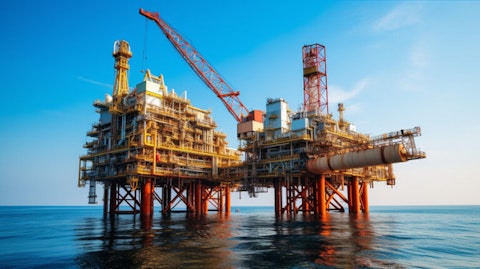In this insightful article, we will discuss the top most resource-rich countries and how they’re capitalizing on their natural wealth. If you want to skip our overview of the mining and extractive sectors, head straight to the Top 8 Countries With Most Natural Resources.
Natural resources, primarily oil, gas, and coal, are indispensable for driving industrial machinery. Countries with massive reserves of these non-renewable resources often boast a robust national income; for example, Qatar has a gross national income of $70,500. Notably, the Organization of the Petroleum Exporting Countries (OPEC), a consortium of 13 nations, controls approximately 80.4% of the world’s proven oil reserves. The revenue generated from exporting these resources is a principal source of wealth in countries with the most natural resources in the world.
The mining and drilling industry, which extracts these resources in affluent countries, significantly contributes to GDP growth. For instance, Guyana made headlines when Exxon Mobil Corporation (NYSE:XOM) discovered vast oil reserves off its coast in 2015. Since this discovery by Exxon Mobil Corporation (NYSE:XOM), there have been multiple significant finds in the region, which has transformed the small South American nation into one of the most promising new oil producers. The Stabroek Block, the most prolific of these discoveries, is estimated to hold over 11 billion barrels of recoverable oil equivalent resources. Due to these abundant reserves, Exxon Mobil Corporation (NYSE:XOM) has approved a $12.7 billion oil project in Guyana.
According to the International Monetary Fund (IMF), Guyana’s GDP growth has been substantial, reaching a record high of 47.8% in 2022, up from 5.35% in 2019. Such significant growth rates in the Top Mining Countries in the World, like Saudi Arabia, Kuwait, and the UAE, largely result from their extractive industries.
Developments In The Natural Resources Horizon
Chevron Corp (NYSE:CVX), the second-largest oil company in the US, is at the forefront of major developments in the oil & gas sector. Operating in 180 countries, the company plays a role in every aspect of the oil industry. For three decades, Chevron has collaborated with Kazakhstan to develop its energy resources, aiding its emergence as a significant energy producer and exporter globally. Chevron Corp (NYSE:CVX) has significantly invested in Tengizchevroil (TCO), Kazakhstan’s largest crude oil-producing field and one of the largest oil fields in the world. This investment has resulted in a fifteen-fold increase in the annual gross production of oil from the 1990s to the 2020s.
According to Chevron’s Q2 earnings call, TCO is anticipated to deliver production exceeding 1 million barrels of oil equivalent daily and generate approximately $5 billion of free cash flow by 2025. Additionally, Chevron has initiated production at 10 wells in New Mexico and expects to introduce 30 more wells with higher production rates by the year’s end to meet the demands of countries with the highest oil consumption.
Reuters reports that Chevron Corp (NYSE:CVX) plans to introduce 65,000 barrels per day (bpd) of Venezuelan oil to the global market by the end of 2024. This initiative marks Chevron’s first major drilling campaign in Venezuela since Washington imposed sanctions on the country in 2019. Chevron’s joint ventures with Venezuelan state oil company PDVSA currently yield 135,000 bpd, and with the addition, production is expected to reach 200,000 bpd by the end of 2024. You can further expand your investment portfolio by reading 10 Best Oil Stocks Under $20.
Another sector gaining traction within natural resources is lithium-ion technology, essential for various electronic devices, including EVs and E-bikes. In this domain, Livent Corporation (NYSE:LTHM), listed among the top 10 lithium mining companies in the world, announced an all-stock merger with Allkem. The merger between Livent Corporation (NYSE:LTHM) and Alkem is poised to establish the third-largest lithium producer globally, with the deal expected to conclude by this year’s end. The merged entity is projected to be valued at $10.6 billion and have a supply chain spanning the Americas, Europe, and Australia, according to Livent Corporation (NYSE:LTHM).
Let’s now talk about the world’s biggest natural resource holders!

Top 20 Countries With Most Natural Resources in the World
Our Methodology
We have listed the top resource-rich countries based on their total natural resources rents, expressed as a percentage of their GDP as of 2021. Natural resources rents refer to the economic gain a country derives from the extraction and production of resources like oil, natural gas, coal, minerals, and forests. Essentially, it’s the difference between the total revenue generated from these resources and the production costs borne by the country. These rents are often represented as a percentage of the country’s GDP. To identify countries abundant in natural wealth, we consulted the World Bank’s database and ranked the world’s biggest natural resource holders in ascending order of the GDP percentage derived from natural resources.
Based on our findings, here are the countries with the most natural resources:
20. Norway
Total Natural Resources Rents As % Of GDP: 10%
Recently, Norway has become Europe’s largest exporter of natural gas and oil following a buyer boycott against Russia due to its invasion of Ukraine. Bloomberg reports that to maintain production levels and increase exports, Norway has approved new oil and gas projects worth $18.5 billion. The Johan Sverdrup oil field, a significant project, produces 31,500 barrels of oil equivalent of gas per day, substantially contributing to the economy.
Located 150 km off the coast of Stavanger, this field reached its maximum production capacity of 755,000 barrels of oil per day during a test phase. Jointly owned by Equinor ASA (NYSE:EQNR), TotalEnergies, Lundin Norway, Petoro, and Aker, the field recently increased its capacity to 755,000 barrels per day, as reported in Equinor ASA (NYSE:EQNR)’s Q2 earnings call transcript.
Equinor ASA (NYSE:EQNR) continues investing in the Norwegian continental shelf’s oil sector, developing Irpa and Verdande (subsea oil fields in the Norwegian Sea) in the upcoming years, which are expected to yield valuable, low-carbon barrels.
19. Venezuela
Total Natural Resources Rents As % Of GDP: 10.1%
Venezuela is among the top oil producing countries in the world, possessing one of the world’s largest proven oil reserves, primarily located in the Orinoco Oil Belt. However, US sanctions imposed in 2019 have significantly hindered its oil production and export capacities.
Targeting the oil sector and government officials, these sanctions have limited Venezuela’s access to global financial markets and deterred foreign investment, causing a decline in oil production levels and prompting the search for alternative trading partners.
18. Peru
Total Natural Resources Rents As % Of GDP: 12.7%
Peru, rich in natural resources, is a leading global producer of silver, copper, lead, and zinc. The significant Antamina mine extracts copper and zinc, eventually supporting its GDP. Additionally, with portions of the Amazon Rainforest within its territory, Peru offers considerable timber and biodiversity resources. However, the exploitation of these resources is controversial due to environmental and indigenous peoples’ rights concerns.
17. Australia
Total Natural Resources Rents As % Of GDP: 13.4%
Australia’s wealth in natural resources encompasses coal, iron ore, gold, and natural gas. The Pilbara region is renowned for extensive iron ore extraction, with projects like Roy Hill making significant contributions. Furthermore, the North West Shelf and the Prelude FLNG project play a crucial role in the country’s natural gas production.
16. Chile
Total Natural Resources Rents As % Of GDP: 16.9%
Topping the list of countries with the largest copper reserves, Chile has reserves amounting to 190 million metric tons. The Escondida mine, the world’s largest of its kind, is pivotal in this regard. In addition to copper, Chile possesses substantial reserves of lithium, molybdenum, and precious metals, with significant lithium extraction occurring in the unique geography of the Atacama Desert.
15. United Arab Emirates
Total Natural Resources Rents As % Of GDP: 17.6%
The UAE derives its wealth predominantly from oil and gas found mainly in Abu Dhabi. The flagship Zakum field, one of the world’s largest oil fields, significantly boosts the nation’s production capacity. Besides oil, the UAE is heavily investing in developing a smart renewable energy sector to diversify its energy portfolio.
14. Russia
Total Natural Resources Rents As % Of GDP: 18.5%
With extensive natural resources, Russia has considerable reserves of oil, gas, coal, and metals. The Yamal LNG project exemplifies Russia’s robust gas production capabilities, providing access to massive reserves in the Russian Arctic.
13. Algeria
Total Natural Resources Rents As % Of GDP: 22.6%
Algeria’s wealth in resources is chiefly in oil and gas, with the Hassi Messaoud and Hassi R’Mel fields being integral to its petroleum industry. Fundamental for both domestic consumption and exports, these fields also support Algeria’s prominent role in the fertilizer industry due to its substantial phosphate reserves.
12. Saudi Arabia
Total Natural Resources Rents As % Of GDP: 25.6%
Primarily known for oil, Saudi Arabia is home to Ghawar Field, the world’s largest crude oil production facility. This field enhances Saudi Aramco’s production capabilities and cements the nation’s status in the global oil market. Additionally, with significant gold and phosphate deposits, Saudi Arabia is also exploring opportunities in the mining sector.
11. Kazakhstan
Total Natural Resources Rents As % Of GDP: 26.8%
Kazakhstan is rich in minerals, including uranium, copper, and zinc. As a leading uranium producer with 969,200 tons of uranium reserves, the country’s Inkai and South Inkai mines are vital to its uranium extraction efforts. Kazakhstan also boasts substantial oil reserves, with the Tengiz Field being a significant contributor to its oil production.
10. Qatar
Total Natural Resources Rents As % Of GDP: 27.3%
With substantial natural gas reserves located primarily in the North Field, Qatar garners global attention. This field is crucial to the nation’s status as one of the leading LNG exporters worldwide. Additionally, the country possesses significant crude oil reserves, bolstering its energy-centric economy.
9. Oman
Total Natural Resources Rents As % Of GDP: 29.2%
Like other Middle Eastern countries on the list, Oman derives the majority of its wealth from oil and gas. The nation has also invested in its emerging mining sector, focusing on the exploitation of copper, gold, and phosphate reserves.
Click to continue reading Top 8 Countries with Most Natural Resources in the World.
Suggested Articles:
- 20 Countries With Highest Gold Consumption By Year
- 10 Best Aluminum and Aluminum Mining Stocks To Buy
- 11 Best Mining Penny Stocks to Buy Now
Disclosure: None. Top 20 Countries with Most Natural Resources in the World was originally published at Insider Monkey.





